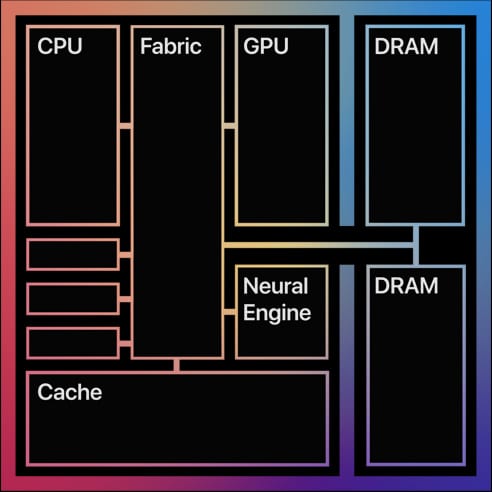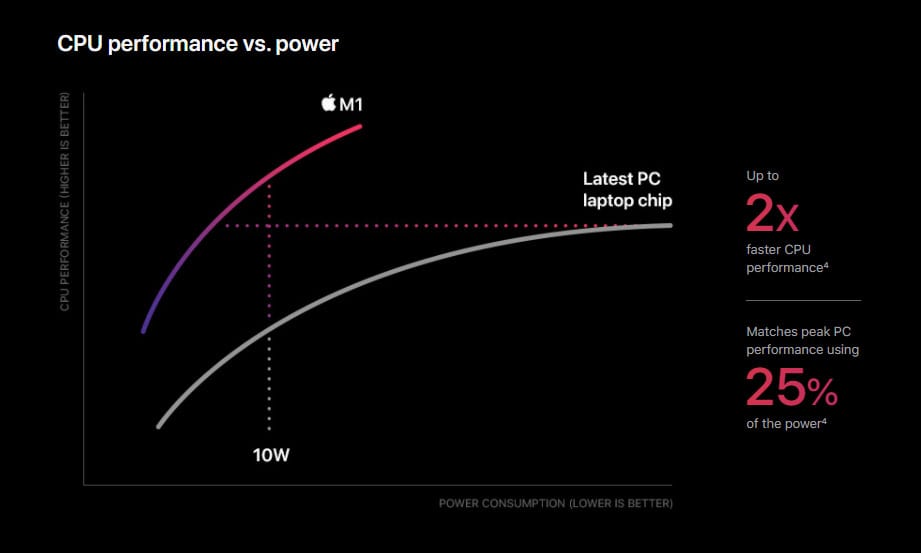During its “One More Thing” event today, Apple announced a new line of Mac computers, including a new MacBook Air, MacBook Pro, and Mac mini. The next-generation Mac computers are all powered by the M1 processor, the first chip designed by Apple specifically for the Mac. This new chip makes Apple’s new line of Macs faster and more energy-efficient than ever before.
Apple’s New M1 Chip
For the past 15 years, Apple has been using processors from Intel in every Mac computer, but that all changed today. Now, the company has announced that the next generation of Mac computers will all run on its new M1 Silicon chip.
Apple’s new M1 chip is based on ARM technology, which was originally designed to work in smartphones and tablets. This technology was optimized for low-power systems, such as MacBook laptops, where size and power efficiency are critically important. So, you can expect every new Mac computer from now on to be more efficient and have a better battery life.
Previously, Macs needed several chips to deliver all its features. But the M1 combines the processor (CPU), graphics (GPU), memory (DRAM), and more in one system. This makes it easier for each of the components to talk to each other.


The eight-core CPU will be divided into two parts, with four “performance cores” that are designed to handle intensive tasks, like video editing and gaming. It also has four “high-efficiency cores” that are designed to handle lightweight tasks, like web browsing and word processing.
Apple claims that its custom-designed chip offers the “world’s best CPU performance per Watt.” When compared to the latest PC laptops chips, the M1 chip delivers twice the CPU performance at 10 Watts. Plus, it can deliver the same peak performance as the latest laptop chips while only using one-quarter of the power, according to Apple.


Apple also claims that the M1 has the “world’s fastest integrated graphics.” The Apple Silicon chip delivers twice the GPU performance of the latest PC laptop chip at 10 W, and it can deliver the same performance as the latest laptop chip’s peak performance while only using one-third the power.
New MacBook Air
The first Mac to take advantage of Apple’s new M1 chip is the new MacBook Air. Because of the advancements in CPU technology, Apple claims that its most popular laptop is now 3.5 times faster than the previous generation. In fact, the new MacBook Air is supposedly faster than 98% of PC laptops sold in the last year.
With the M1, the next-generation MacBook Air is so efficient that it doesn’t even need a fan to stay cool. That means this lightweight laptop will be completely silent, even when you are pushing it to the limit.
In addition, the new MacBook Air has a much longer battery life that can last up to 15 hours when browsing the web and 18 hours when watching videos. That’s six hours longer than the previous generation.
When you are video chatting, you will look and sound better with the three studio-quality mics and an upgraded camera. Plus, the Retina display was improved to deliver more vibrant colors.
The new MacBook Air starts at $999 or $899 for education users. It comes in three colors, including space gray, gold, and silver. You can order it today from the Apple Store, and they will start shipping sometime “next week.”
You can get this model with up to 2 TB of SSD storage space and either 8 GB or 16 GB of memory (also known as RAM). If you want to know more about what RAM is and how much memory you need, check out our article here.
New MacBook Pro
Apple also announced that the new MacBook Pro, which runs on the same M1 chip, will be faster and more energy-efficient as well. According to Apple, the new Pro line of MacBooks will be 2.8 times faster than the previous model and three times faster than the best-selling Windows laptop in its class.
Apple’s new Pro line of MacBooks will still include a fan, but it will have a longer battery life than the new MacBook Air. The battery will supposedly last up to 17 hours when browsing the web and up to 20 hours when watching videos. That’s double the battery life of the previous model, and it’s also Apple’s longest battery life in any Mac ever.
The new MacBook Pro will start at $1,299 and $1,199 for education users. It only comes in two colors, including space gray and silver. It is available today from the Apple Store, and it will start shipping next week.
You can get the new MacBook Pro with up to 2 TB of SSD storage space and up to 16 GB of RAM. It has two USB-C ports that can support up to 6K resolution on an external monitor.
New Mac Mini
Finally, Apple also released a new Mac mini, which is three times faster than the previous version. This compact computer is up to five times faster than the best-selling Windows desktop in its price range, but it’s only one-tenth of the size.
The Mac mini is like a tiny version of a desktop tower, so you will have to connect it to a monitor. The back of the new Mac mini features an HDMI 2.0 port, which supports 4K monitors, and two USB ports that support 6K monitors.
The new Mac mini starts at $699, which is $100 lower than the previous generation. It is available today from the Apple Store, and it will be shipped next week. Just like the new MacBook Air and MacBook Pro, you can get the Mac mini with up to 2 TB of SSD storage and up to 16 GB of RAM.
Apple Releases macOS 11 Big Sur
All of Apple’s new Macs will run on macOS 11, also known as Big Sur. The company’s latest operating system (OS) was designed to harness the power of the M1 chip. This allows new Macs to launch apps almost instantaneously and instantly wake from sleep, just like the iPhone and iPad do.
Plus, you will be able to run your favorite iPhone apps and iPad apps directly from your Mac computer. And, even if an app was not optimized to run on the new macOS, it will run better with the M1.
Whether you get a new Mac, or you just want to update your current computer, macOS Big Sur will be available starting November 12. If you want to know more about what you will get with macOS Big Sur, check out our article on Apple’s WWDC event, where the new operating system was announced.


